You’ve probably noticed your electricity bill creeping higher each month, but you might not realize that a simple technology upgrade could slash those costs by up to 35%. Motion sensors aren’t just convenient gadgets—they’re powerful energy-saving tools that automatically eliminate one of your home’s biggest sources of waste: lights burning unnecessarily in empty rooms. The math behind these savings reveals something most homeowners never consider about their daily habits.
Understanding Motion Sensor Technology and How It Works

Motion sensors revolutionize how you control lighting by automatically detecting movement and responding accordingly.
These devices utilize two primary technologies: Passive Infrared Sensors (PIR) that detect infrared radiation from warm bodies, and ultrasonic sensors that use sound wave reflections to identify motion. You’ll find both suitable for indoor and outdoor applications.
For enhanced accuracy, dual-technology sensors combine PIR and ultrasonic capabilities, reducing false alerts especially in homes with pets.
You can adjust sensitivity and duration settings to customize operation based on your specific needs. This technology delivers substantial energy savings by illuminating areas only when movement’s detected, preventing lights from staying on unnecessarily and dramatically reducing your electricity costs through smart automation.
The Science Behind Automatic Energy Reduction
When sensors detect your presence, they trigger an immediate response that transforms how energy flows through your lighting system. The Passive Infrared Sensors (PIR) technology reads heat signatures from your body movement, instantly activating lights only when you’re present.
This precise detection eliminates unnecessary illumination periods that traditional systems can’t control. Your energy consumption drops dramatically because lights operate solely during occupied periods.
The sensors prevent phantom energy use by ensuring lights don’t remain on when you’ve left the area. When you combine this smart activation with LED technology, you’ll achieve maximum energy efficiency through reduced wattage and extended bulb lifespan.
This automated approach cuts your monthly energy costs by approximately $0.22 per low-traffic area, creating substantial long-term savings.
Quantifying Real Energy Savings With Motion-Activated Lighting
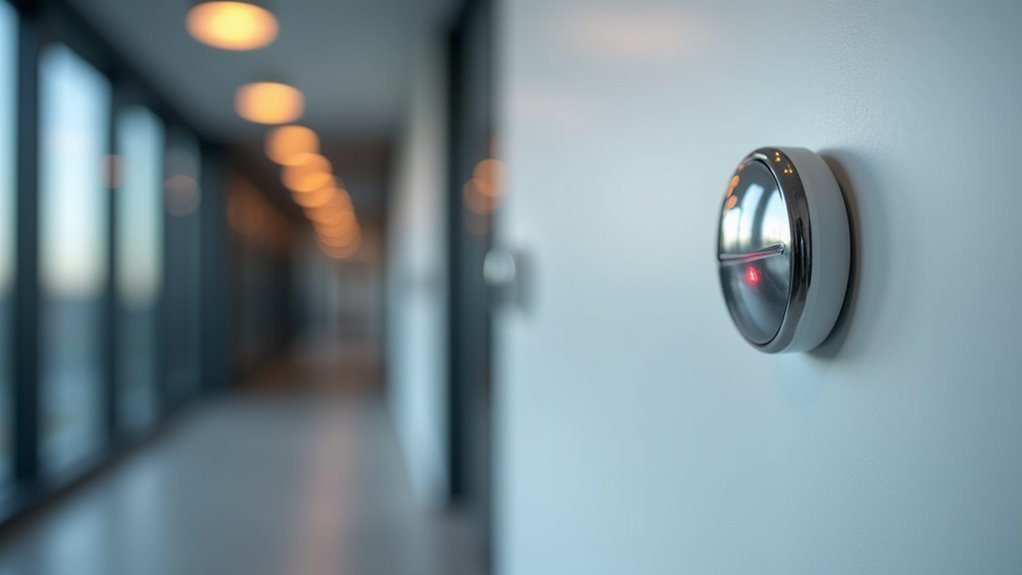
Since you’re investing in motion-activated lighting, you’ll want concrete numbers that demonstrate your actual savings. Motion sensors deliver measurable energy savings by automatically shutting off lights in unoccupied spaces, reducing consumption by 30-35% across various settings.
| Setting Type | Monthly Energy Costs | Potential Savings |
|---|---|---|
| Residential | $0.22 | 60-watt equivalent for 33 hours |
| Commercial | Variable | 30-35% reduction |
| Hotel/Facility | Significant | Redirected operational funds |
You’ll see immediate reductions in your electricity bills, especially in low-traffic areas where lights typically remain on unnecessarily. These systems prevent phantom energy use while maximizing efficiency through occupancy-based illumination. The cumulative energy savings you’ll achieve can be redirected toward other operational improvements, making motion sensors a financially smart investment.
Cost-Benefit Analysis of Motion Sensor Installation
Understanding the financial impact requires examining both upfront costs and long-term returns from motion sensor installations.
You’ll find that low-traffic areas like bathrooms and utility rooms deliver the strongest returns, with monthly energy costs dropping to approximately $0.22 compared to traditional switches.
Your savings become equivalent to powering a 60-watt bulb for 33 hours when you install sensors in these areas.
You can amplify these benefits by combining motion sensors with energy-efficient lighting systems. LED bulbs consume 75% less energy than incandescent options, creating a powerful energy management solution.
While high-traffic areas won’t yield significant returns, you’ll see substantial cumulative savings in guest rooms and bathrooms where lights often stay on unnecessarily for extended periods.
Best Locations for Maximum Energy Efficiency Impact

Where should you install motion sensor switches to maximize your energy savings? Focus on low-traffic areas where lights often remain unnecessarily on.
Bathrooms and utility rooms are perfect candidates since they’re frequently unoccupied for extended periods. Your garage benefits greatly from motion sensors, eliminating energy waste when the space sits unused.
Install sensors in hallways to prevent lighting long, empty corridors. Guest bedrooms offer excellent energy savings opportunities due to irregular occupancy patterns—lights will only operate when visitors are actually present.
Don’t overlook outdoor areas like pathways and driveways. Strategic placement enhances safety while ensuring lights activate only during active use.
These locations collectively provide the highest return on investment, transforming your property into an energy-efficient environment that responds intelligently to actual usage patterns.
Motion Sensors Vs Traditional Light Switches: Energy Comparison
You’ll find that motion sensors consume notably less energy than traditional switches when you analyze actual usage patterns in your home.
Your monthly electricity bill can drop by approximately $0.22 per switch beyond existing costs, especially when you replace switches in low-traffic areas like bathrooms and utility rooms.
Motion sensors use only 1-5 watts depending on their mode, while traditional switches often result in lights burning unnecessarily for hours, wasting energy equivalent to a 60-watt bulb running for 33 hours.
Energy Consumption Analysis
When you’re weighing the energy costs between motion sensors and traditional light switches, the numbers reveal a clear winner.
Motion sensors consume just 1 watt in standby mode and 5 watts when active, resulting in monthly costs of only $0.22. Traditional switches can’t match this efficiency since they rely on manual operation and often leave lights running unnecessarily.
You’ll reduce energy consumption by up to 30-35% when installing motion sensors in your space.
In low-traffic areas like guest rooms, you’re preventing waste equivalent to a 60-watt bulb running 33 hours monthly. The automatic shut-off feature guarantees lights operate only when needed, unlike standard switches that depend on human memory to turn off lights.
Cost Savings Breakdown
Although the upfront investment in motion sensors might seem costly, your electricity bills will reflect immediate savings that compound over time.
Motion sensors consume just 1 watt in standby mode and 5 watts when active, costing approximately $0.22 monthly—dramatically less than traditional switches left on accidentally.
Here’s your cost savings breakdown:
- Low-traffic areas: You’ll save energy equivalent to a 60-watt bulb running 33 hours monthly in bathrooms or guest rooms.
- Consumption reduction: You’ll achieve 30-35% lower electricity usage in intermittent-use spaces.
- Automatic shutoff: You’ll eliminate accidental energy waste from forgotten lights.
- Long-term benefits: You’ll see compound savings while contributing to sustainability efforts.
These costs reductions make motion sensors a smart investment for any energy-conscious homeowner.
Efficiency Performance Metrics
Since motion sensors activate lights only when detecting movement, they consistently outperform traditional switches in energy efficiency metrics across all residential applications.
You’ll see dramatic differences when comparing energy consumption patterns between these technologies. Motion sensors use approximately 5 watts during active operation for one hour daily, costing you just $0.09 monthly. Meanwhile, traditional switches maintain constant power flow regardless of occupancy patterns.
Your phantom energy use drops to 1 watt in standby mode with motion sensors, while conventional switches offer no such efficiency.
In low-traffic areas, you’ll save energy equivalent to running a 60-watt bulb for 33 hours. This performance gap becomes especially pronounced in spaces with irregular foot traffic, where motion sensors prevent lights from remaining unnecessarily illuminated during unoccupied periods.
LED Integration Amplifies Motion Sensor Savings
You’ll maximize your energy savings when you pair motion sensors with LED bulbs, creating a powerful combination that can slash consumption by at least 75% compared to traditional incandescent lighting.
This smart lighting approach doesn’t just reduce your electricity bills—it also extends bulb life to 50,000 hours while minimizing heat production and cooling costs.
The return on investment becomes even more compelling when you consider that commercial facilities have achieved 30-35% energy cost reductions through strategic LED motion sensor implementations.
LED Motion Sensor Benefits
When you integrate LED technology with motion sensors, you’ll amplify your energy savings to unprecedented levels.
This powerful combination delivers exceptional benefits that transform how you consume energy:
- Massive Energy Reduction – You’ll slash energy consumption by at least 75% compared to traditional incandescent bulbs, dramatically lowering your utility bills.
- Extended Lifespan – LED lights last up to 50,000 hours, approximately 25 times longer than incandescent bulbs, reducing your replacement costs and maintenance efforts.
- Smart Illumination – Motion sensing guarantees lights activate only when needed, preventing unnecessary electricity usage and reducing your carbon footprint.
- Proven Savings – Commercial applications like Candlewood Suites hotels achieve 30-35% energy savings through this LED motion sensing combination.
Combined Technology Energy Savings
While LED lights alone deliver substantial energy reductions, pairing them with motion sensors creates a synergistic effect that multiplies your savings potential exponentially.
You’ll achieve at least 75% energy savings compared to traditional incandescent bulbs when combining these technologies. This automated lighting system guarantees lights activate only when spaces are occupied, preventing wasteful electricity usage.
Real-world implementations demonstrate impressive results. When you retrofit facilities with LED-motion sensor combinations, you can expect energy savings of 30-35%, as proven by Candlewood Suites’ successful deployment.
The 50,000-hour lifespan of LED bulbs means you’ll spend less on replacements and maintenance costs. Beyond reducing electricity bills, this integrated approach considerably cuts your carbon footprint, helping you meet sustainability goals while maximizing financial returns.
Smart Lighting ROI Analysis
Smart lighting systems that integrate LEDs with motion sensors deliver exceptional return on investment, with payback periods as short as 1-2 years in most commercial applications.
You’ll see dramatic reductions in energy usage when combining these technologies, creating a compelling financial case for upgrading your facility’s lighting infrastructure.
Your smart lighting investment generates measurable returns through:
- Energy savings of up to 75% compared to traditional incandescent systems
- Annual cost reductions of approximately $3,000 in commercial spaces like hotels and retail stores
- Extended bulb lifespan up to 50,000 hours—25 times longer than incandescent alternatives
- Cumulative energy savings of 30-35% across your entire facility
These combined efficiencies mean you’ll offset upfront installation costs quickly while enjoying continuous operational savings for decades.
Outdoor Motion Lighting: Security Meets Energy Efficiency
As darkness falls around your property, outdoor motion lighting transforms your home’s security strategy while dramatically cutting energy costs.
You’ll eliminate the waste of traditional lighting that burns continuously through the night, as advanced sensors activate only when movement’s detected. This smart lighting technology slashes energy consumption by at least 75% when you combine LED bulbs with motion detection.
Your security benefits double as potential intruders face sudden illumination while you enjoy minimal energy use during quiet periods.
You can customize sensitivity and duration settings to match your specific needs and environmental conditions. For maximum efficiency, consider solar-powered motion lights that operate independently from your electrical grid, delivering both enhanced protection and sustainable energy savings.
Smart Motion Sensors and Advanced Energy Management Features
Beyond basic outdoor activation, today’s motion sensors incorporate sophisticated energy management capabilities that transform how you control your entire home’s lighting and climate systems.
These smart devices integrate seamlessly with extensive energy management platforms, delivering substantial reductions in energy consumption.
Here’s how advanced motion sensors maximize your savings:
- Automatic HVAC coordination – Sensors adjust heating and cooling based on real-time occupancy, achieving 30-35% energy savings.
- Customizable sensitivity settings – You’ll fine-tune detection zones and timer intervals to match your specific usage patterns.
- LED integration benefits – Combined with LED bulbs, you’ll consume 75% less energy than traditional incandescent lighting.
- Low-traffic optimization – Smart sensors can save energy equivalent to a 60-watt bulb running for 33 hours in unused areas.
Common Installation Mistakes That Reduce Energy Savings
Poor installation practices can slash your motion sensor’s energy savings by up to 50%, turning a smart investment into a costly mistake.
Positioning sensors too high or facing wrong directions limits detection range, preventing your motion-activated light from activating when needed. Incorrect sensitivity settings trigger false alarms from pets or vehicles, causing unnecessary energy waste.
Installing sensors in high-traffic areas where lights stay on constantly eliminates automatic shut-off benefits.
Outdoor sensors without ambient light consideration activate during daylight, wasting energy when natural light suffices. Neglecting maintenance allows dirt and obstructions to accumulate, degrading sensor performance over time.
These installation errors transform energy-saving devices into inefficient systems that increase rather than reduce your electricity costs.
Calculating Your Potential Monthly Utility Bill Reduction
When you’re considering motion sensor installation, understanding your potential savings requires calculating actual energy consumption patterns in your specific spaces.
You’ll need to assess current energy use across different areas to determine realistic reduction expectations.
Here’s how to calculate your monthly savings:
- Measure current usage – Track lighting systems runtime in hallways, restrooms, and low-traffic areas for one week.
- Apply reduction percentages – Use the 30-35% savings rate for high-impact spaces like corridors and bathrooms.
- Factor operational costs – Motion sensors cost approximately $0.22 monthly when operating one hour daily.
- Calculate net savings – Subtract sensor operational costs from reduced lighting expenses.
Low-traffic rooms can save energy equivalent to a 60-watt bulb running 33 hours monthly, making calculations straightforward for accurate projections.
Motion Sensor Technology for Different Room Types and Usage Patterns
Different room types require specific motion sensor approaches since usage patterns vary dramatically throughout your home.
You’ll find motion sensors most effective in low-traffic areas like bathrooms and utility rooms, where they can save up to $0.22 monthly by ensuring lights activate only when needed. These sensors excel in spaces with irregular usage patterns, such as guest bedrooms and hallways, preventing lights from staying on unnecessarily.
However, don’t expect significant savings in high-traffic areas like kitchens and living rooms where you’re constantly turning lights on and off anyway.
Motion sensors offer minimal benefits in busy spaces like kitchens where lights are frequently used throughout the day.
Motion sensors reduce energy consumption by automatically shutting off lights after preset inactivity periods, making them perfect for stairwells and corridors that don’t need constant illumination while promoting overall energy efficiency.
Environmental Impact and Carbon Footprint Reduction
You’ll substantially reduce your carbon emissions by installing motion sensors, as they eliminate unnecessary lighting in unoccupied spaces.
Your energy conservation efforts can achieve up to 75% savings when you combine motion sensing technology with LED lighting systems.
You’re contributing to sustainable technology impact that collectively prevents millions of tons of carbon emissions annually across commercial and public facilities.
Reduced Carbon Emissions
Since motion sensors activate lights only when movement is detected, they drastically cut your home’s energy consumption and shrink your carbon footprint.
You’ll see remarkable environmental benefits when you install these smart devices throughout your property.
Here’s how motion sensors reduce carbon emissions:
- Automatic Operation – You’ll eliminate wasteful lighting habits since sensors guarantee lights turn off immediately when rooms become unoccupied.
- LED Integration – When you pair motion sensors with LED bulbs, you’re using 75% less energy than traditional incandescent lighting.
- Significant Savings – You can reduce your household’s overall energy usage by 30-35%, directly lowering greenhouse gas emissions.
- Collective Impact – Your individual conservation efforts contribute to national energy savings and reduced fossil fuel dependence.
Energy Conservation Benefits
Beyond reducing carbon emissions, motion sensors deliver substantial energy conservation benefits that extend far beyond your individual home. When you install motion sensing lights, you’re contributing to national energy savings that can prevent millions of tons of CO2 emissions annually.
The environmental impact becomes even more significant when you combine motion sensors with LED technology, which uses 75% less energy than traditional incandescent bulbs.
You’ll see remarkable energy conservation in low-traffic areas like bathrooms and utility rooms, where motion sensors can save energy equivalent to operating a 60-watt bulb for 33 hours monthly.
Your adoption of this technology supports broader sustainability initiatives by reducing fossil fuel reliance and minimizing overall environmental degradation across residential and commercial sectors.
Sustainable Technology Impact
When properly implemented, motion sensors create a ripple effect of environmental benefits that extend throughout entire communities and ecosystems.
You’re not just reducing your energy bills—you’re actively participating in carbon footprint reduction that makes a measurable difference.
Your motion sensor installation contributes to sustainability through these key impacts:
- Fossil fuel reduction – You’ll decrease electricity demand, reducing power plant emissions by up to 35%
- National conservation – Your energy savings join cumulative efforts supporting broader conservation goals
- Greenhouse gas elimination – You’re directly cutting thousands of pounds of CO2 emissions annually
- Sustainable awareness – You’re promoting responsible energy practices that influence others
This technology transforms your space into an environmental ally, proving that smart automation and sustainability work hand-in-hand for meaningful change.
Future Innovations in Motion-Activated Energy Saving Technology
As motion sensor technology continues to evolve, you’ll witness groundbreaking innovations that’ll revolutionize how buildings manage energy consumption.
Real-time occupancy analysis will enable precise motion-controlled lighting based on actual usage patterns, dramatically boosting efficiency. You’ll see solar-powered motion sensors reducing grid dependence while cutting energy costs further.
Solar-powered motion sensors will deliver precise occupancy-based lighting control while dramatically reducing grid dependence and energy costs.
Advanced algorithms will analyze historical data to improve sensor accuracy, eliminating false triggers that waste energy in residential and commercial spaces.
Smart home integration will automatically adjust lighting and HVAC systems through motion detection, delivering 30-35% energy savings similar to Candlewood Suites’ results.
Future sensors will offer customizable settings and remote control capabilities, enhancing user experience while promoting energy management engagement.
These innovations position motion-activated technology as essential for sustainable building operations.
Frequently Asked Questions
Do Motion Sensors Save Electricity?
Yes, you’ll save electricity with motion sensors. They automatically turn lights off when you’re not around, preventing wasted energy. You can save equivalent to running a 60-watt bulb for 33 hours monthly.
What Are the Benefits of Motion Sensors?
You’ll reduce electricity bills through automatic on/off functionality, minimize false triggers with advanced technology, save approximately $0.22 monthly, enhance sustainability credentials, and achieve 30-35% energy reductions when properly implemented.
How Much Money Do Motion Sensor Lights Save?
You’ll save approximately $0.09 monthly on residential energy costs with motion sensor lights. In commercial spaces, you can achieve 30-35% energy reductions, with some facilities saving thousands annually through automated lighting systems.
What Is the Role of Sensors During Saving Energy?
Sensors detect your presence and automatically control lighting, ensuring you’re only using energy when spaces are occupied. They’ll turn lights off when you leave, preventing waste and reducing your electricity bills considerably.

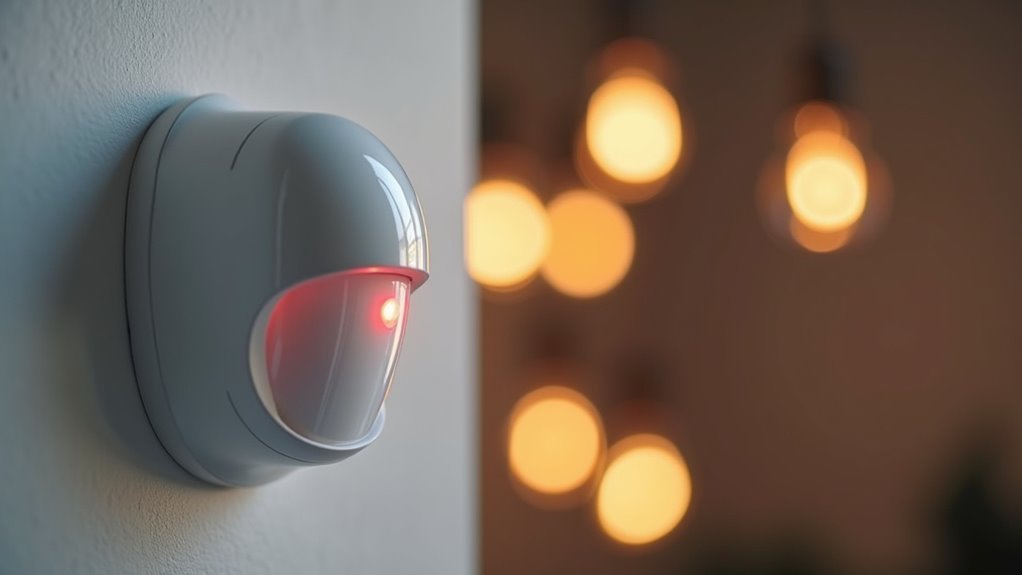
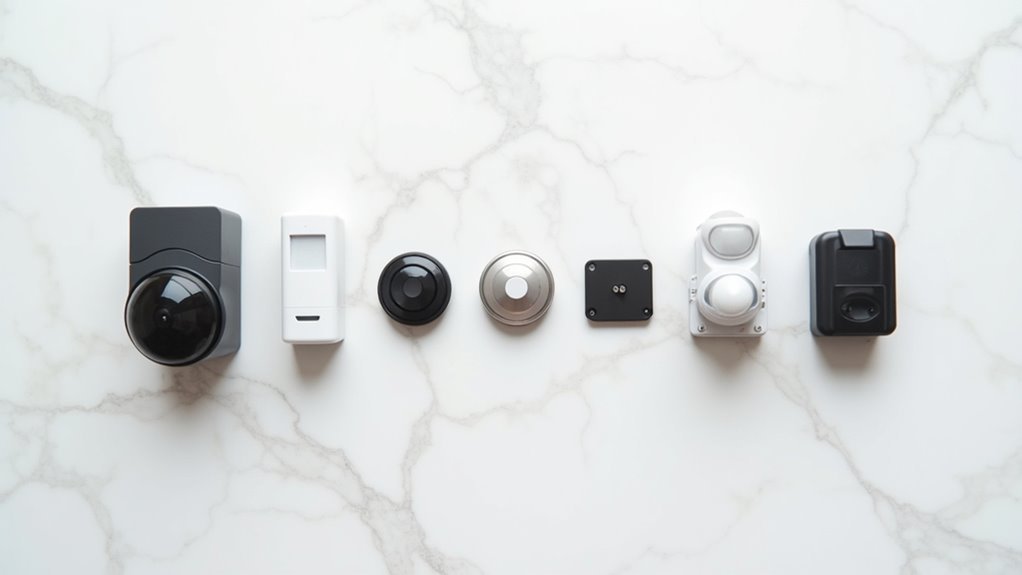
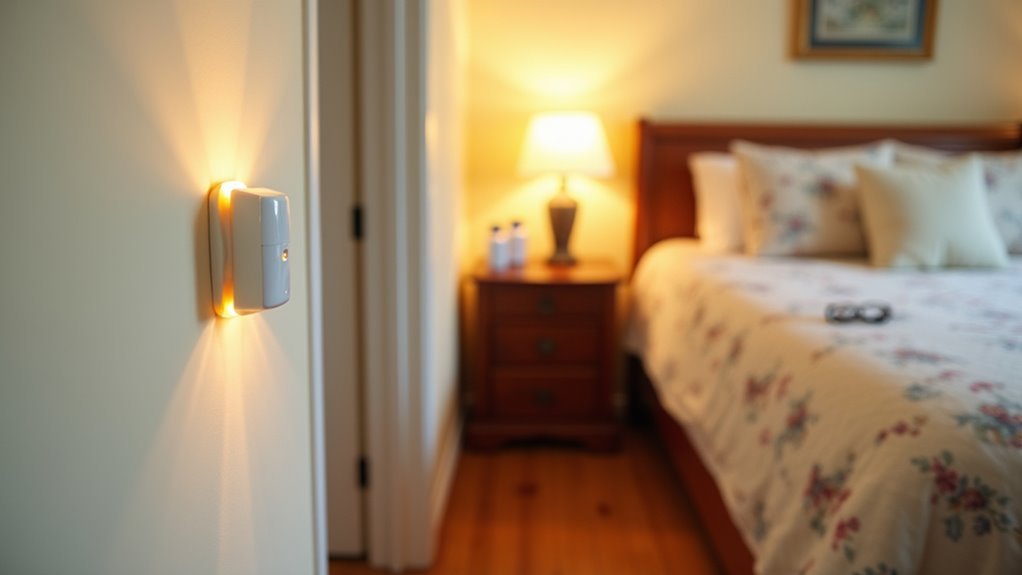
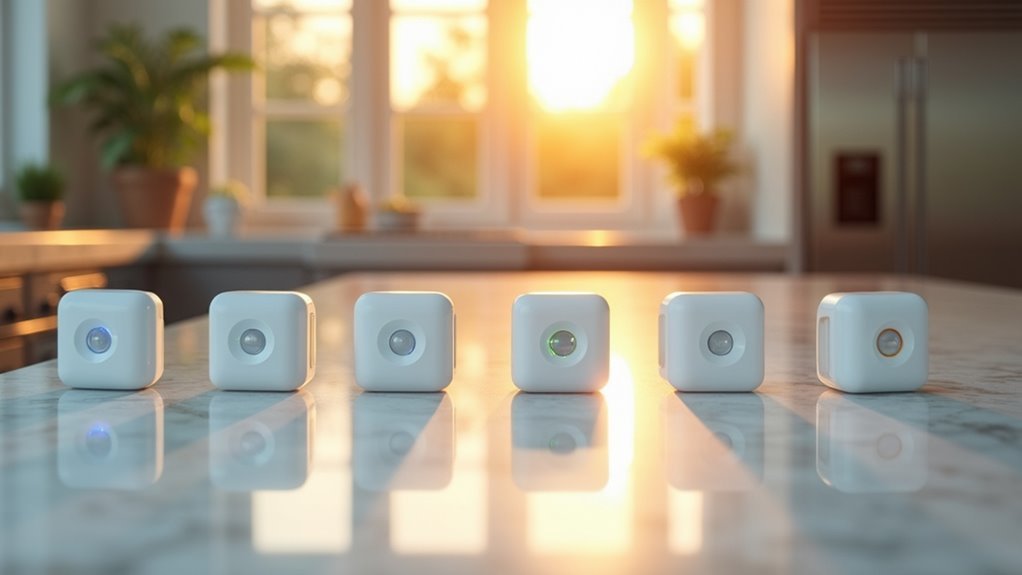
Leave a Reply